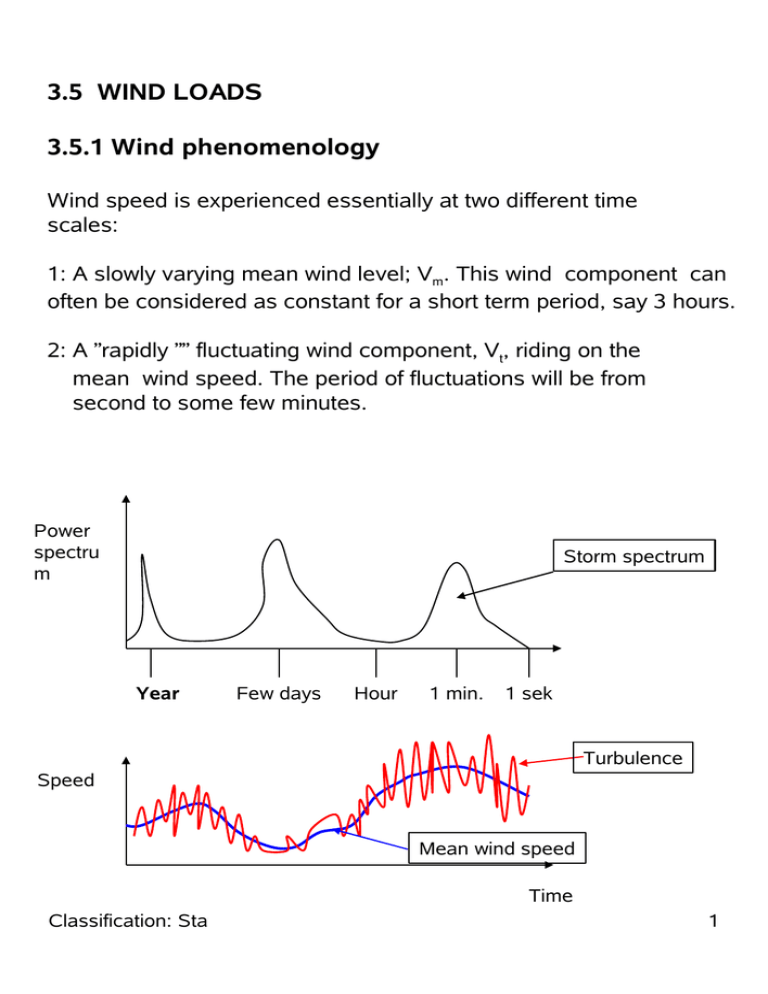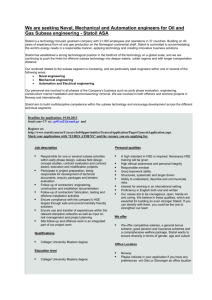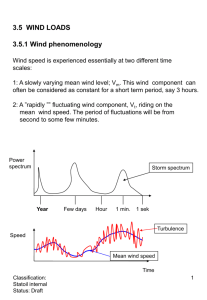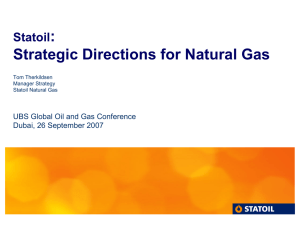Overview environmental processes and environmental loads
advertisement

3.5 WIND LOADS
3.5.1 Wind phenomenology
Wind speed is experienced essentially at two different time
scales:
1: A slowly varying mean wind level; Vm. This wind component can
often be considered as constant for a short term period, say 3 hours.
2: A ”rapidly ”” fluctuating wind component, Vt, riding on the
mean wind speed. The period of fluctuations will be from
second to some few minutes.
Power
spectru
m
Storm spectrum
Year
Few days
Hour
1 min.
1 sek
Turbulence
Speed
Mean wind speed
Classification: Statoil internal
Time
Status: Draft
1
At a given point, the resulting wind speed can be written:
V(t) = Vm(t) + Vt(t)
The mean wind speed is typically the largest. Terrain
roughness govern the ratio. The ratio between standard
deviation of Vt and Vm is called turbulence intencity.
Typical turbulence intencity over ocean with storm
waves is about 0.12.
The wind speed varies with height, see eq(1a – 1d) in
Statoil metocean report.
For engineering purposes, the mean wind speed is
described by a distribution function often close to a Rayleigh
distribution. The mean direction is described by a probability
mass function for direction sectors (often) of 30 deg. width.
The mean wind speed corresponds to a given length of
averaging. Standard meteorological averaging is 10 min..,
in design the length of averaging is often taken to be 1 hour.
Wind speed will increase with decreasing length of averaging.
The ration between a 15sek average and a 1-hour average
10m above sea level is 1.37, see table in Statoil report for
other examples.
Example of a wind description for design purposes is shown
by Statoil Metocean report.
Classification: Statoil internal
Status: Draft
2
For structures or structural components where the turbulent
wind may cause a dynamic behaviour, the frequency spectrum
for wind speed is given by Eq. (2a and 2b) of Statoil Report or
Norsok N-003.
This wind spectrum is deduced from wind measurements at
Frøya.
The turbulent wind is not fully correlated over the size of
structures. Coherence spectrum between two points are
given in Statoil report or Norsok N-003.
The loads on structures not exposed to dynamic behaviour
can be calculated considering the wind as static:
If structural dimensions are less than 50m, 3s gust should be
used.
If structures are larger, 15s gust can be used.
For structures which are exposed to simultaneous actions
from wind and waves, and where the wave loading is
dominating, the length of averaging of wind gust may be taken
to be 1 minute. Check with coming editions of Norsok for
possible changes.
Classification: Statoil internal
Status: Draft
3
3.5.3 Wind forces
The wind force is proportinal to the wind speed squared:
F = k * (Vm + Vt)2 = Vm2 + 2VmVt + Vt2 =(ca) Vm2 +2VmVt
The mean wind gives a constant force on the structure,
while the turbulent wind yields a force proportional the the
turbulent wind speed.
Practical problems:
Offset and mooring line forces for ships and floating
platforms.
The natural periods of the surge, sway and yaw are often
in the order of 1-2 minute, i.e. a period band where the
wind frequncy spectrum has a considerable power density.
For this sort of problem, a dynamic analysis has to be
carried out involving the wind power spectrum.
Wind loading on flare towers and drilling towers. A quasistatic analysis is often possible accounting for some
dynamics by a proper dynamic amplification factor.
The wind loading on complicated structures are determined
by means of tests in wind tunel.
Remember that in all cases mentioned above, one will also
have to include the simultaneous affect of waves.
Classification: Statoil internal
Status: Draft
4
The static wind force on a structural member or surface
acting normal to the member or surface is given by:
FW = ½ ρ C A V2 sinα
C – shape coefficient, see DNV 30.5
ρ – density of air (= 1.225 kg/m3 for dry air)
A – projected area of member normal to force direction
α – angle between wind and axis of the exposed member
For the wind load of a plane truss, the load can be
calculated by using A as the enclosed area of truss if an
effective shape parameter is used, C=Ce, and the
transparancy of the truss is accounted for by multiplying
the area with the solidity ratio φ. Ce is found in DNV 30.5.
If more than one member or truss are located behind each
other, shielding effect can be accounte for by multiplying
loads given above by the shielding factor, η. Values for η
are given in DNV 30.5.
Regarding the shape coefficicent, it is recommended that
DNV 30.5 or an similar reference are consulted.
NB: For structural sides not facing the wind, a considerable
suction force can occurr, see Fig. 3.14 b in kompendium,
Moan (2004).
Classification: Statoil internal
Status: Draft
5
If structure or structural component can be exposed to wind
induced dynamics, the variability of the wind force is to be
accounted for:
FW (t,z) = ½ C ρ A (Vm(z)2 + 2* Vm(z)*Vt(z,t)) * sin α
It is seen that load is linear with respect to wind speed (since
Vt2 term is neglected). If the wind induced response is linear
function of load, the wind response may be obtained using
frequency domain analysis, i.e. the cross spectral density
for the dynamic wind load is multiplied by response transfer
function in order to obtain response spectra for dynamic
wind induced response.
Alternatively, wind histories for a number of load points may
be simulated from wind spectrum and corresponding time
histories for the response found by solving the equation of
motion in time domain.
The total extreme wind induced response can be found by:
F3h-max (Vm) = Fm + g * σ(Vm)
g – extreme value factor for 3-hour maximum dyn. response
σ – standard deviation of wind response under consideration
Classification: Statoil internal
Status: Draft
6
Vortex Induced Vibrations (brief introduction)
Vortex shedding frequency in steady flow is given by:
f = St * V/D
St is the Strouhal number, V is wind speed and D is structural
diameter.
A critical velocity is defined as the velocity giving vortex
shedding frequencies equal to the natural frequency of
the structural member:
VC = 1/St * fN * D
fN – natural frequency of structural member.
St is a function of the Reynolds number, Re = VD/ν, where
ν is the kinematic viscosity of air, (= 1.45*10-5 m2/s at 15o
and standard atmospheric pressure. St is given in Fig. 7.1
in DNV 30.5.
A state of quasi-resonant vibriations of a member may take
place if wind velocity is in the range:
K1*VC < V < K2*VC
If possible, one should require: VC > 1/K1 *Vmax
Not always possible and maybe unnecessary strict criterium.
Classification: Statoil internal
Status: Draft
7
3.6 Wave and Current loads
Water levels:
Maximum still water level
Positive
storm surge
Tidal
range
Highest astronomical tide (HAT)
Mean still water level
Lowest astronomical tide (LAT)
Negative
storm surge
Minimum still water level
Classification of structures
* hydrodynamic transparent (slender structures, Morison
loading)
* hydrodynamic compact (large volume structures,
diffraction analysis)
Classification: Statoil internal
Status: Draft
8
When to account for which effects?
Figur:
Faltinsen(1995)
Dragleddet
dominerer
Linearisere
dragledd ?
Masseleddet
dominerer
Diffraksjonsanalyse
Morisons ligning
Hastighetspotensial:
Kraftintensitet:
1
π
f = ρ c D d u | u | + ρ c M d 2 u
2
4
6
Φ = Φ i + Φ d +∑ Φ k
Innkommende
k =1
Bevegelsesindusert
Bølger viktigst
Classification: Statoil internal
Dragledd
Masseledd
Bølger og strøm viktig
Status: Draft
9
3.6.2 Current velocity field
For most design work, current profiles (speed versus depth)
are established from current measurements.
Measurements are typically made at a number of depths. Up
to now extremes are typically estimated for each depth
separately. Linear interpolation between depths.
10-1 – design profile
It is likely that such profiles are concervative for most cases,
but not necessarily for all.
Presently work is going on regarding developing more
adequat design profile:
* Current is described as a sum of empirical orthogonal
functions.
* Family of profiles with 10-2 speed at one depth and
associated values at other depths.
Classification: Statoil internal
Status: Draft
10
Current components:
* Tidal current.
* Background current.
* Wind driven current
* Meanders or vortex current
If data are not avvailable, current field may be taken as the
sum of the tidal current (constant through water column)
and the wind driven current (= 1-2% of mean wind speed at
the surface decaying linearly to zero at about 50m.
In connection with loads on structures, the current is
considered as a slowly varying phenomenon, i.e. the
current speed is kept constant for a short term sea state.
Typical surface current speed North Sea (no eddies present):
10-1 - current: 1m/s
Classification: Statoil internal
Status: Draft
11
3.6.3 Waves and descrition of waves
The sea surface is of an irregular nature, but it can to a
first appoximation be written as a sum of sinusoidal with
different amplitude, different frequency, (different direction)
and different phase.
For practical application, the long term variation of the sea
surface elevation process is consider as i piecewise
stationary (and homogeneous) stochastic process (field).
If the sea surface elevation can be modelled as a Gaussian
process, each stationary sea state is in a statistical sense
completely characterized by the directional wave spectrum:
Sh(f, θ) = sh(f)*d(θ)
Spreading function
Frequency Spectrum
Several models are proposed for the frequency spectrum:
* ISSC (Generalized Pierson Moskowitz, fully developed
wind sea)
* JONSWAP (pure wind sea, may be growing)
* Torsethaugen (combined sea, wind sea + swell)
Common for all models is that they are parameterized in
terms of significant wave height, hs, and spectral peak
period, tp.
Classification: Statoil internal
Status: Draft
12
Long term modelling of sea states
In view of what is said above, one can conclude that a
short term sea state is for practical purposes described
in terms of significant wave height, spectral peak period
and direction of propagation.
The long term description of wave conditions can be done
by establishing a joint probability density function for
Hs, Tp and Θ:
fHs,Tp,Θ(h,t,θ) = f Hs,Tp|Θ (h,t|θ)*fΘ(θ)
where:
approximated
by prob. mass
function
fHs,Tp(h,t) = fHs(h) * fTp|Hs(t|h)
3-p Weibull
or
LonoWe
Log-normal or
Weibull
fitted to data for each
hs - class
Fitted to available data
Classification: Statoil internal
Status: Draft
13
Short term modelling of sea states
It is most common to use long crested sea. This may be
non-conservative for ships heading into sea with respect to
assess ship rolling.
Select spectral model in view of problem to be considered.
Valg av spektrum er lettest
å gjøre når en vet hvilke
sjøtilstander som er viktige.
Torsethaugen
JONSWAP
ISSC
hs
hs-tp
område
tp
Classification: Statoil internal
Status: Draft
14
Torsethaugen versus JONSWAP
Hs = 10.0m , Tp = 10s
250
Torsethaugen
200
JONSWAP (rød)
Torsethaugen (gul)
JONSWAP
150
100
50
0
0
0,04
0,08
0,12
0,16
0,2
Frequency (Hz)
Hs = 10.0m , Tp = 14s
250
Spectral density (m**2*s)
hs=10m
tp=10s
Torsethaugen
200
JONSWAP
150
100
50
0
0
0,04
0,08
0,12
0,16
0,2
Frequency (Hz)
hs = 10m
tp = 14s
Hs = 10.0m, Tp =20s
hs = 10m
tp = 20s
Spectral Density (m**2*s)
Spectral density (m**2*s)
300
250
Torsethaugen
200
JONSWAP
150
100
50
0
0
0.04
0.08
0.12
0.16
0.2
Frequency (Hz)
For a further illustration of how to descibe sea states in
short and long term for practical applications, see e.g. the
Statoil Metocean report.
Classification: Statoil internal
Status: Draft
15
Prediction of extreme sea states and waves
Sea states
Various approaches are used:
* All sea state approach (based on modelling Hs and Tp
for all 3-hour stationary sea states. Most commonly
adopted approach in Norwegian waters
* Peak over threshold approach (based on modelling
merely storm peak characteristics. Most common in
areas of a mixed population wave climate, i.e. a distinct
difference between normal conditions and stom conditions.)
In the following we will stay with the first approach:
The number of 3-hour sea states per year is 2920 if all
directions and seasons are pooled together:
The 10-2 – probability significant wave height is then
estimated by:
1 – FHs(h_10-2) = 1/ (2920*100)
Corresponding peak period:
E (T p |H s =h _ 10 −2 ) = ∫ t f T p |H s (t | h _ 10 −2 ) dt
t
Classification: Statoil internal
Status: Draft
16
If structural response is rather sensitive to the peak
period, it is not necessarily the highest 10-2 sea state
that is the most critical. In order to cover these needs
lines of hs and tp corresponding to a constant probability
of exceedance are often provided:
It will be indicated later how such a contour can be used
for design load calculations.
Classification: Statoil internal
Status: Draft
17
Prediction of extreme individual waves
For a number of response problems, the sea surface process
can for practical applications be modelled as a Gaussian
process. If the purpose of the assessment is to predict
accurate extreme individual waves, this should not be done.
Regarding crest height, a proper model is the distribution
recommended by Forristall.
Where:
Short term extreme value:
FC(c3hmax) = 1- FC(c3hmax) = 1/m3h
Characteristic maximum
Classification: Statoil internal
No. of crest heights
in 3 hours.
Status: Draft
18
Forristall model is based on fitting a Weibull model to a huge
number of simulations of second order surfaces for various
conditions.
3 0
S e c o n d o rd e r p ro c e s s
2 5
G a u s s ia n p r o c e s s
S u rf a c e e le v a t io n ( m )
2 0
S e c o n d o r d e r c o r r e c t io n
1 5
1 0
5
0
-5
-1 0
-1 5
-2 0
3 7 0 0
3 8 0 0
3 9 0 0
T im e
4 0 0 0
4 1 0 0
(s )
Regarding wave heights, the model proposed by Arvid Næss
(1985) is recommended. This model is a bandwidth corrected
Rayleigh distribution.
Classification: Statoil internal
Status: Draft
19
Regarding a prediction of long term extremes, a long term
analysis should be carried out:
F X x =∫t ∫h F X
3h max
3h max∣H s T p
x∣h ,t f H T h ,tdhdt
s p
The 10_2 crest height is then given by:
1- FX3hour (x_10-2) = 1/ = 10-2 / 2920
Alternatively, one may use the environmental contour
principle. This includes the following steps:
a) Find worst sea state along 10-2 contour line.
b) Establish the distribution function for the 3-hour maximum
crest height.
c) An estimate for the 10-2 crest height is obtained by
adopting the 90-percentile of this distribution.
Classification: Statoil internal
Status: Draft
20
A so far unsolved question regarding waves, is the possible
existence of freak waves.
D ra u p n e r w a v e re c o rd
J a n u a r y 1 1 9 9 5 a t 1 5 :2 0 , h s = 1 2 m
S u r fa c e e le v a tio n
(m )
20
16
12
8
4
0
-4
-8
100
140
180
220
260
300
340
380
T im e (s )
(From: BBC Horizon)
Classification: Statoil internal
Status: Draft
21
picture of the ”world ”
Status: Draft
Locally very non - Gaussian surface
Crest height
x 3h_max
Corresponding population
of 3 - hour maxmum crest height
x 3h_max
Corresponding population
of 3 - hour maxmum crest height
population , x 3h_max / h s will exceed e.g . 1.25 a number of times.
B: Locally very non - Gaussian surface
Within the base case
Crest height
Nearly Gaussian surface
A: Base case design
Classification: Statoil internal
22
What can be the problem if freak waves exist?
For ship and platforms, freak waves will
mainly be a problem if their crest become so
high that it impacts structural members not
being designed for wave loading.
?
?
The above scenario is completely unacceptable,
In particular for manned structures, it is therefore
a good idea to ensure a reasonable robustness
against unexpectedly large crest heights.
For a given site freak waves if they exist are most
probably so rare that they will not effect our 10-2
and 10-4 predictions. But if a possible freak wave
mechanism will occur more frequently in sea states
beyond thos thatr are observed so far, this conclusion
may have to be adjusted.
Classification: Statoil internal
Status: Draft
23
Wave loads
Figur:
Faltinsen(1995)
Dragleddet
dominerer
Linearisere
dragledd ?
Masseleddet
dominerer
Diffraksjonsanalyse
Morisons ligning
Hastighetspotensial:
Kraftintensitet:
1
π
f = ρ cD d u | u | + ρ cM d 2 u
2
4
6
Φ = Φi + Φd +∑Φk
Innkommende
k =1
Bevegelsesindusert
For the purpose of
this course, we will
assume these loads to be
linear and characterized
by a transfer function.
Classification: Statoil internal
Dragledd
Masseledd
In the following we
will focus on these
type of loads.
Status: Draft
24
3.6.5 Large volume structures
Fixed platforms
Most important load is wave frequency load. The load is
Most often approximated very well by a linear potential
theory. The loadis typically described by the transfer
function or response amplitude operator:
H(ω) = x(ω)/η(ω)
where η(ω) is a harmonic wave, η(ω) = η0exp(-iωt) and
x(ω) is the response due to this harmonic wave, x(ω) =
x0 exp(-i(ωt+ε))
H(ω) = x0/h0 exp(-i ε) = |H(ω)| exp(-iε)
A closed for solution for H(ω) can be found for some few
cases, most of the time H(ω) is found for the various
frequencies using numerical methods.
In addition to the wave frequency load, there will also be
a slowly varying force on the platform corresponding to
difference frequencies and a high frequency load
corresponding to the sum frequencies. These are much
lower than the wave frequency load, but the high frequency
load may for some structures hit the largest natural
period and thus cause som resonant response. This is
referred to as ringing.
Classification: Statoil internal
Status: Draft
25
Floating structures
The same can be said as for the fixed platforms. However,
the slowly varying load can now hit the natural period of
the horisontal modes of motion and cause rather large
offset motiona and mooring line forces.
For a TLP the sum frequency term can hit the natural period
of the vertical modes of motions
Response calculations
Select a sea state, hs and tp. The wave spectrum is then
known. As the transfer function has been calculated, the
response spectrum is given by:
sx(ω) = | H(ω)|2 sη(ω)
The variance and zero-up-crossing frequency can be
found from the spectral moments, m0 and m2.
THe response process can often be assumed to be Gaussian,
this means that the global maxima of the response process
is desribed by the Rayleigh distribution.
FXmax | Hs,Tp (x | hs,tp) = 1 – exp(-0.5 (x / σX)2), σX = σX(hσ, tp)
Classification: Statoil internal
Status: Draft
26
Long term distribution of Xmax is given by:
FX x=
max
{ }
1
1
x
ν
h
,t
1−
exp
−
−
∫
∫
0
2 σ X h ,t
ν0 h t
2
f H s T p h , t dt dh
10-2 response maximum is given by:
1 − FX max ( x _ 10 −2 ) =
10 −2
365 * 24 * 3600 *ν 0+
Alternatively, the environmental contour approach can be
adopted. However, for linear systems one may just as
well do a classical long term analysis as indicated above.
Classification: Statoil internal
Status: Draft
27







